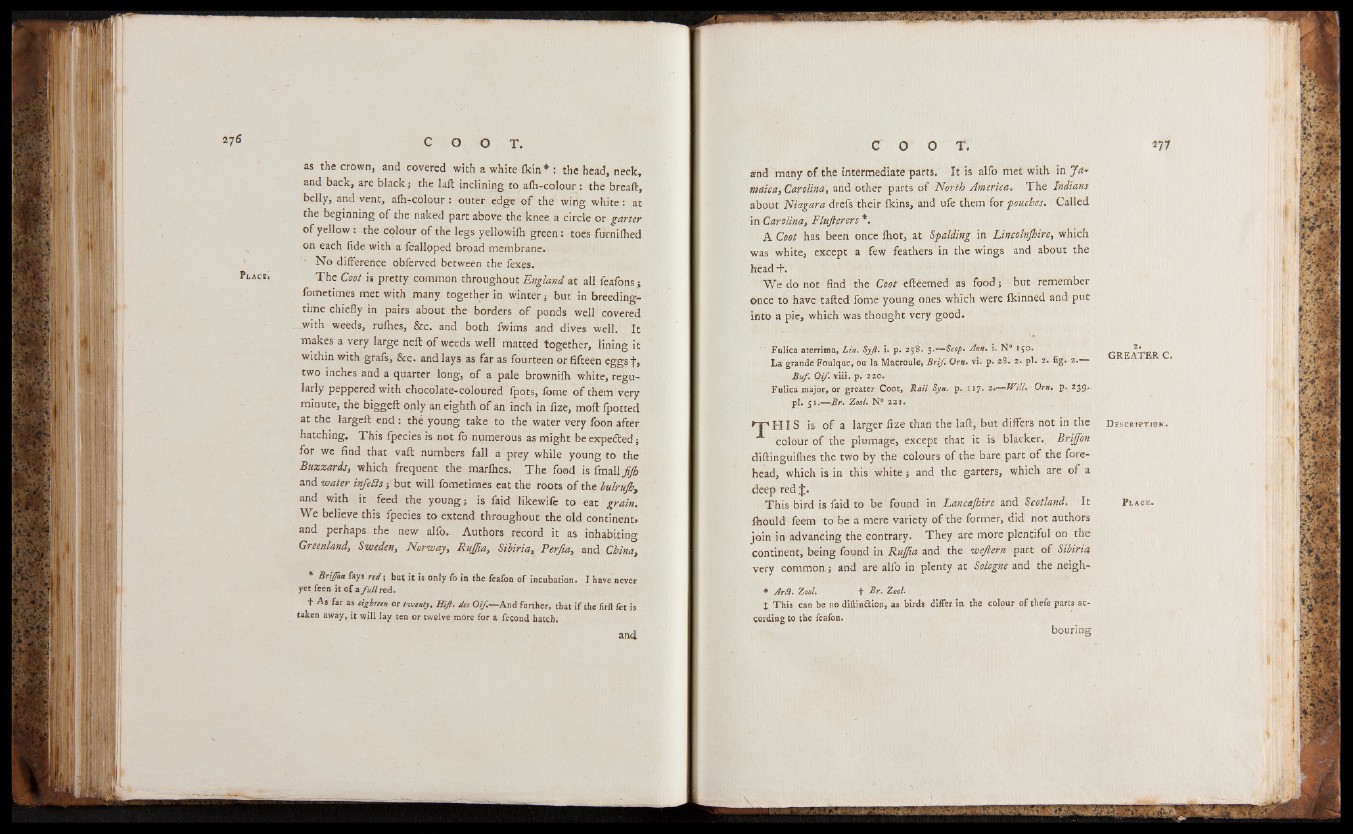
27 6
Place*
C O O T .
as the crown, and covered with a white fldn * : the head, neck,
and back, are black ; the laft inclining to alh-colour: the breaft,
belly, and vent, alh-colour: outer edge of the wing white: at
the beginning of the naked part above the knee a circle or garter
of yellow: the colour of the legs yellowilh green: toes furnilhed
on each fide with a fcalloped broad membrane.
| No difference obferved between the 1exes.
The Coot is pretty common throughout England at all feafons j
fometimes met with many together in winter; but in breedino--
time chiefly in pairs about the borders of ponds well covered
with weeds, rufhes, &c. and both fwims and dives well. It
makes a very large neft of weeds well matted together, lining it
within with grafs, &c. and lays as far as fourteen or fifteen eggs-!*,
two inches and a quarter long, of a pale brownilh white, regularly
peppered with chocolate-coloured lpots, lome of them very
minute, the biggeft only an eighth of an inch in fize, moll fpotted
at the largeft end : the young take to the water very fbon after
hatching. This fpecies is not lo numerous as might be expefted;
for we find that vaft numbers fall a prey while young to the
Buzzards, which frequent the marlhes. The food is fmall fijh
and water infests j but will fometimes eat the roots of the bulrujh,
and with it feed the young ; is faid likewife to eat grain.
We believe this fpecies to extend throughout the old continent*
and perhaps the new alfo. Authors record it as inhabiting
Greenland, Sweden, Norway, Ruffia, Sibiria, Perfia, and China,
Briffbn fays red ; but it is only fo in the feafon of incubation* I have never
yet feen it of a fu ll red.
+ As far as eighteen or twenty, Hift. des Oif.— And further, that if the firft let is
taken away, it will lay ten or twelve more for a fecond hatch.
c o o T . 277
and many of the intermediate parts. It is alfo met with in 'Jamaica,
Carolina, and other parts of North America. The Indians'
about Niagara drefs their Ikins, and ufe them (or pouches. Called
in Carolina, Fluftcrcrs *,
A Coot has been once Cbot, at Spalding in Lincolnjhire, which
was white, except a few feathers in the wings and about the
head +.
We do not find the Coot elteemed as food; but remember
once to have tailed fome young ones which were Ikinned and put
into a pie, which was thought very good.
2.
GREATER C.
D escription.
Place.
Fulica aterrima, Lin. Syfi. i. p. 258. 3.— Scop» Ana. i. N° 150.
La grande Foulque, ou la Macroule, Brif. Orn. vi. p. 28. 2. pi. 2. fig. 2.—
Buf. Oif. viii. p. 220.
Fulica major, or greater Coot, Raii Syn. p. 117* 2.-—Will. Orn• p. 239..
pi. 51.— Br. Zool. N° 221.
r -p H IS is of a larger fize than the laft, but differs not in the
colour of the plumage, except that it is blacker. Brijfon
diftinguilhes the two by the colours of the bare part of the forehead,
which is in this white; and the garters, which are o f a
deep red J.
This bird is faid to be found in Lancajhire and Scotland, It
lhould feem to be a mere variety of the former, did not authors
join in advancing the contrary. They are more plentiful on the
continent, being found in RuJJia and the weftern part of Sibiria
* Jr SI. Zool. + Br. Zool.
X This can be no diftin&ion, as birds differ in the colour of thefe parts according
to the feaibn.